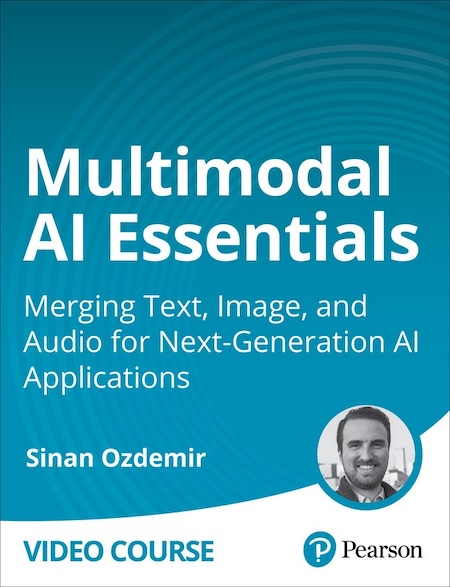English | MP4 | AVC 1280×720 | AAC 44KHz 2ch | 5h 33m | 2.01 GB
Equips you with the knowledge and skills needed to implement multimodal AI systems
Multimodal AI Essentials: Merging Text, Image, and Audio for Next-Generation AI Applications shows you how combining modalities like text, audio, video, and images can enable AI systems to achieve remarkable capabilities. You will gain hands-on experience building visual question and answering models, generating personalized images with diffusion, designing end to end multimodal applications, and even fine-tuning multimodal models for specific tasks. This video gives you the tools, knowledge, and confidence to design and deploy your own state-of-the-art multimodal AI systems.
Learn How To
- Apply multimodal AI concepts
- Build a voice-to-voice app
- Apply visual question answering (VQA) concepts and architecture
- Construct, fine-tune, and evaluate diffusion models with DreamBooth
- Fine-tune a text-to-speech model with SpeechT5
- Build visual agents from the ground up
- Evaluate the performance of multimodal models
- Extend multimodal systems with advanced techniques like computer use
Lesson 1: Introduction to Multimodal AI
Lesson 1 lays the groundwork for the course by introducing the core concepts of multimodal AI and its applications. It explores the significance of combining modalities like text, images, and audio to unlock a new frontier in AI development. By the end of this lesson, you will understand the transformative potential of multimodal AI systems and their impacts across industries.
Lesson 2: Building Visual Question Answering (VQA) Models
In Lesson 2 you dive into the intricacies of constructing visual question and answering (VQA) systems with Sinan, models capable of answering questions about images. Through examples and architectural walkthroughs, you learn how to embed and fuse these modalities together effectively, gaining real insights into the applications of VQA.
Lesson 3: Exploring Diffusion Models
Lesson 3 introduces diffusion, a groundbreaking approach in image generation. Unlike traditional methods, diffusion models iteratively refine noisy images to create coherent outputs. The lesson explores the theory behind both forward corruption and backwards diffusion. You also implement your own fine-tuned version of diffusion using a technique known as DreamBooth.
Lesson 4: Developing Multimodal AI Systems
Lesson 4 focuses on the practical aspects of designing and implementing multimodal AI applications. From fine-tuning text-to-speech models to building your own visual agent, the lesson demonstrates how to create cohesive systems that handle diverse input and output modalities.
Lesson 5: Evaluating and Testing Multimodal AI Systems
Lesson 5 covers evaluation metrics, benchmarks, and the ethical considerations involved in testing multimodal AI systems. It also discusses bias mitigation and responsible AI practices, covering topics like the LLMs as multimodal judges and the proliferation of Deepfakes.
Lesson 6: Expanding and Applying Multimodal AI
Lesson 6 explores advanced techniques and future trends in multimodal AI. You will see how we can extend existing AI systems with cutting edge methods, integrating novel data types. The lesson also anticipates the direction of this rapidly evolving field and its future applications, including things such as computer use for generalized AI agentic behavior.
Table of Contents
Introduction
Multimodal AI Essentials: Introduction
Lesson 1: Introduction to Multimodal AI
Topics
1.1 Overview of Multimodal AI Concepts
1.2 Types of Data in Multimodal Systems
1.3 Building a Voice-to-Voice App
Lesson 2: Building Visual Question Answering (VQA) Models
Topics
2.1 Understanding VQA: Concepts and Architecture
2.2 Fusing Modalities to Perform VQA
2.3 Blending Modalities to Perform VQA
Lesson 3: Exploring Diffusion Models
Topics
3.1 Introduction to Diffusion Models
3.2 Hands-On: Implementing Diffusion Models with DreamBooth
Lesson 4: Developing Multimodal AI Systems
Topics
4.1 Designing Multimodal AI Systems
4.2 Fine-Tuning a Text-to-Speech Model with T5
4.3 Building Visual Agents
Lesson 5: Evaluating and Testing Multimodal AI Systems
Topics
5.1 Evaluating Multimodal Models: Accuracy and Performance
5.2 Bias and Ethics in Multimodality
Lesson 6: Expanding and Applying Multimodal AI
Topics
6.1 Extending Multimodal Systems with Advanced Techniques
6.2 Future Trends and Innovations in Multimodal AI
Summary
Multimodal AI Essentials: Summary
Resolve the captcha to access the links!
